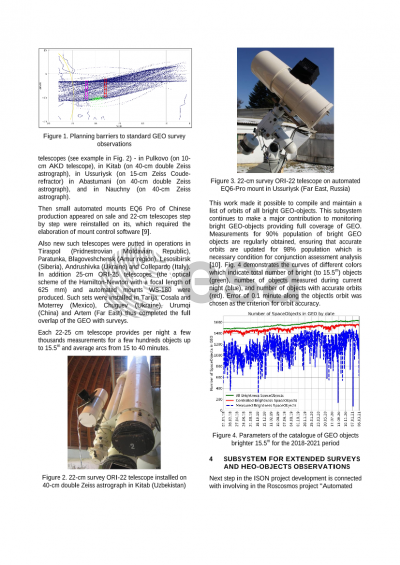Document details

Abstract
International scientific optical network (ISON) project started in 2004 as open international voluntary project on self-financing basis to be an independent source of data for scientific and applied purposes about natural and artificial space objects. At different stages of the project, as the level of knowledge about space debris, new tasks and problems appeared that required the development of new tools and methods for monitoring the near Earth space. At the first stage, attempts were made to use the telescopes that remained in observatories since the USSR for observations of space objects. But after the start of regular research, it became obvious that outdated non-automated telescopes with small fields of view (FOV) and insufficient sensitivity are not suitable. Since the GEO remained the most unexplored at that time, the main focus was on small survey telescopes with FOV 4x4 degree that could dig through the entire visible part of the GEO overnight. This work made it possible to compile and maintain a list of orbits of all bright GEO-objects. In connection with involving into work of Roscosmos system on prognosis of dangerous situations it were elaborated small telescopes with FOV 7x7 degrees and developed the extended surveys, significantly increases the accuracy of the orbits for all bright GEO-objects by multiple scans for the night. In the next stage a goal was to increase knowledge about faint debris fragments at GEO, and a methodology of local GEO surveys has been developed to detect uncataloged objects with 50-cm and 65-cm telescopes with FOV 2x2 degrees. Next task was to detect more objects in highly elliptical orbits (HEO). To solve this problem, two-tube and four-tube telescope systems were developed and implemented in the framework of Roscosmos observatories, with FOV 9x7 and 9x14 degree. But the discovery of a significant number of HEO-objects, including faint ones, has led to new problems. Quality of the catalog has become significantly uneven for different types of objects. For bright space objects, regular orbit updates are provided and 90% of them have accurate orbits, which allow using this catalog for conjunction assessment analysis. While in part of faint space objects 20% of the orbits of are regularly updated only, so the quality of catalog of faint GEO and HEO objects has decreased due to a decrease in the percentage of objects with accurate orbits – down to 50%. Also the number of GEO and HEO fragments constantly changes (periodically decreasing by tens of percent). Therefore, the next stage of ISON development is being implemented now. Concept of the barrier cluster telescope, which realizes an oblong total field of view, was developed for observations of НEO objects in the perigee region. In addition, first 40-cm telescope of new generation with field of view 5.6x4.2 degree is putting in operation to perform full deep surveys of GEO. Additional tracking telescopes are being installed, which are used to fulfill the foreign orders for satellite observations, as well as to improve the accuracy of the orbits of calculated pairs of approaching satellites.
Preview







